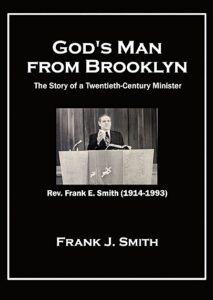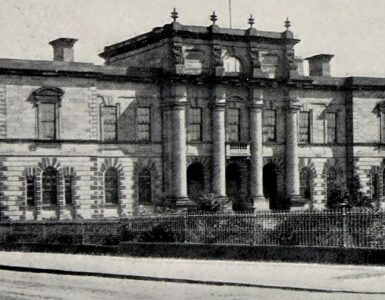 When looking back over the history of American Presbyterianism the biographies of some influential figures have been composed by their descendants. For example The Life of Archibald Alexander was edited by his eldest son, J. W. Alexander; Thornwell Jacobs, president of Oglethorpe University, wrote about his father in The Life of William Plumer Jacobs; and Louisa Cheves Stoney edited her grandfather’s work in Autobiographical Notes, Letters and Reflections, by Thomas Smyth. A strength of these works is the writers likely had access to resources such as private papers, correspondence, journals, and stories from surviving family members to enhance their books. A weakness of such books is objectivity is sometimes lacking, but Frank J. Smith revives this approach in a reasonable fashion in God’s Man from Brooklyn: The Story of a Twentieth-Century Minister. The subject of the book is his father, Frank E. (Edward) Smith, who was one of the ministers involved in establishing the Presbyterian Church in America (PCA). The author is currently pastor of the Atlanta Reformed Presbyterian Church and more can be learned about him on the church website at, “About Pastor Frank J. Smith.” PLease note that three men named Frank are mentioned in this review–Frank the father of Frank E., and his son Frank J. Smith.
When looking back over the history of American Presbyterianism the biographies of some influential figures have been composed by their descendants. For example The Life of Archibald Alexander was edited by his eldest son, J. W. Alexander; Thornwell Jacobs, president of Oglethorpe University, wrote about his father in The Life of William Plumer Jacobs; and Louisa Cheves Stoney edited her grandfather’s work in Autobiographical Notes, Letters and Reflections, by Thomas Smyth. A strength of these works is the writers likely had access to resources such as private papers, correspondence, journals, and stories from surviving family members to enhance their books. A weakness of such books is objectivity is sometimes lacking, but Frank J. Smith revives this approach in a reasonable fashion in God’s Man from Brooklyn: The Story of a Twentieth-Century Minister. The subject of the book is his father, Frank E. (Edward) Smith, who was one of the ministers involved in establishing the Presbyterian Church in America (PCA). The author is currently pastor of the Atlanta Reformed Presbyterian Church and more can be learned about him on the church website at, “About Pastor Frank J. Smith.” PLease note that three men named Frank are mentioned in this review–Frank the father of Frank E., and his son Frank J. Smith.
Frank Edward was born in Brooklyn in December 1914 to Frank and Ethyl Smith. Just a few years earlier his father had changed his surname to Smith from Schlappendorf hoping to avoid the persecution suffered by German Americans in the era leading up to and including the First World War. The author traces the family genealogy in detail and tells of their life in New York City while Frank and his sister Gertrude attended public schools. When the home was split by divorce and Ethyl remarried, Frank dropped out of high school and joined the Navy to get away from the situation and his stepfather. After the Navy, Frank settled in Miami as the Florida land boom was fizzling. His landlady invited him to Shenandoah Presbyterian Church where he came to faith in Christ. On Valentine’s Day 1942 he married Melanie, who was also converted at Shenandoah. A few months earlier Pearl Harbor was attacked and Frank was soon serving in the army. When the war ended he worked for a few years before coming to the conviction that he was called to the ministry. But the path to ministry would not be easy because his limited educational background meant he would have a long journey of study before licensure and ordination. But because of his age and the influence of his presbytery he was accepted by Columbia Seminary in Decatur, Georgia, to study for the ministry under the extraordinary clause of the Book of Church Order of the PCUS. The extraordinary clause allowed presbyteries to reduce the educational requirements stipulated by the Book of Church Order in the case of candidates for whom the full requirements would be a special hardship. Following graduation from Columbia in 1955, he was licensed and ordained by Atlanta Presbytery to serve the Ebenezer Church in Hogansville, Georgia. He continued in the PCUS serving churches in Florida, Alabama, and North Carolina before accepting a call to a church in the mountains of Tennessee.
Smith’s ministry in Tennessee began when during the summer 1970 meeting of Holston Presbytery he was received to become an assistant minister at First Presbyterian Church in Johnson City. His primary work was in a poor area of town in Keystone Chapel, but after a short time his work shifted to a mission at near-by Midway. During this time organizations including Concerned Presbyterians and Presbyterian Churchmen United were troubled about liberal trends in the PCUS. It was decided a new denomination was needed and the Steering Committee for a Continuing Presbyterian Church was formed. In 1973 the Presbyterian Church in America (PCA) was established. Frank E. Smith was removed from the pulpit of the Midway Church and “divested without censure” by the Presbytery of Holston for his influencing churches to leave the PCUS. After a few more years, he returned to his home state of New York to pastor until his death in 1993.
Frank J. Smith has provided a sympathetic but reflective account of his father Frank E. Smith’s life and ministry within the context of the Continuing Church movement and founding of the PCA. If the book had been written in the nineteenth century, he might have titled it, The Life and Times of Frank E. Smith, God’s Man From Brooklyn, given his extensive use of geographical, social, political, and historical information to enhance the biographical narrative. The 262 pages of the book include a detailed index and numerous illustrations. Readers will find the book a pleasant narrative as they learn of the author’s love and appreciation for his father’s ministry in his context. Also, additional historical information about the PCA is available from the author’s important and informative, History of the Presbyterian Church in America: Silver Anniversary Edition, 1999. Both titles are available from the PCA Bookstore.
Barry Waugh
Notes–The header shows the Brooklyn Bridge crossing the East River as viewed from Manhattan towards Brooklyn. From the NYPL Digital Collection, “Brooklyn Bridge from N. Y. City,” The Miriam and Ira D. Wallach Division of Art, Prints and Photographs: Picture Collection; the postcard is postmarked Aug. 20, 1906.





